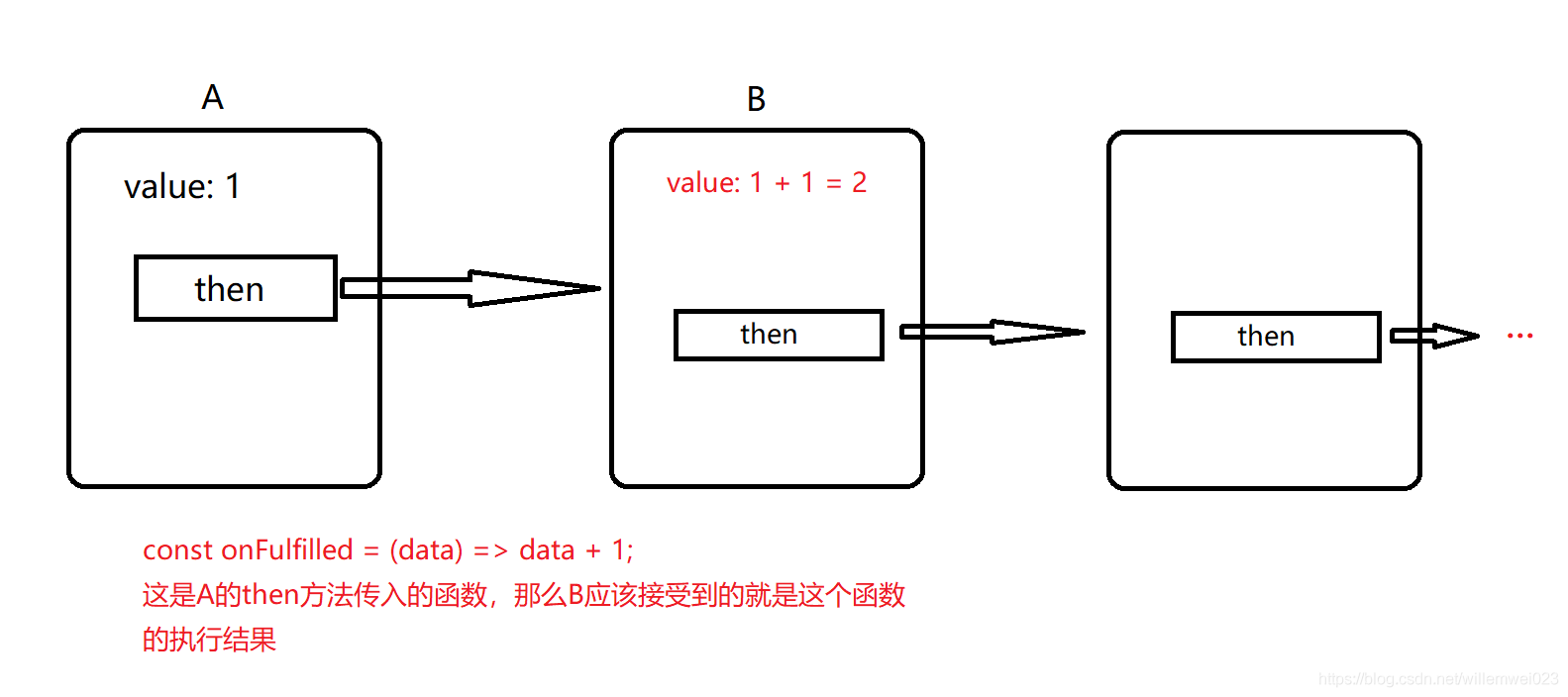前端开发中经常会用到Promise,不过有部分人并不清楚Promise的原理,本文也是本人在学习Promise时对Promis的一些认识,希望能对各位童鞋有所帮助。
手写Promise - 实现一个基础的Promise
手写Promise - 实例方法catch、finally
手写Promise - 常用静态方法all、resolve、reject、race
从认识Promise开始。。。
/* 模拟一个简单的异步行为 */functionfetchData(){returnnewPromise((resolve, reject)=>{setTimeout(()=>{resolve('willem');},1000);});}fetchData().then((data)=>{// after 1000ms
console.log(data);// willemreturn'wei';},(err)=>{}).then((data2)=>{
console.log(data2);// wei});上面的例子算是一个最常见的用法,可能在使用的时候更多的使用的是catch来处理异常来替代then方法的第二个参数,但catch也只是一个then的语法糖。
从中我们可以用一些句子来描述Promise。
- promise是一个类,它的构造函数接受一个函数,函数的两个参数也都是函数
- 在传入的函数中执行resolve表示成功,执行reject表示失败,传入的值会传给then方法的回调函数
- promise有一个叫做then的方法,该方法有两个参数,第一个参数是成功之后执行的回调函数,第二个参数是失败之后执行的回调函数。then方法在resolve或者reject执行之后才会执行,并且then方法中的值是传给resolve或reject的参数
- promise支持链式调用
有了相应的描述,接下来就是来一步一步实现了。
简单版Promise
1. promise是一个类,它的构造函数接受一个函数,函数的两个参数也都是函数
第一点比较简单
// 这里没有使用Promise作为类名是为了方便测试classWPromise{constructor(executor){// 这里绑定this是为了防止执行时this的指向改变,this的指向问题,这里不过多赘述executor(this._resolve.bind(this),this._reject.bind(this));}_resolve(){}_reject(){}}2. 在传入的函数中执行resolve表示成功,执行reject表示失败,传入的值会传给then方法的回调函数
成功、失败,这个很容易想到使用一个状态进行标记,实际上Promise就是这样做的。在Promise中使用了pending、fulfilled、rejected来标识当前的状态。
pending初始状态,既不是成功,也不是失败状态。等待resolve或者reject调用更新状态。fulfilled意味着操作成功完成。rejected意味着操作失败。
需要注意的一点是,这三个状态之间只存在两个变换关系:
pending转换为fulfilled,只能由resolve方法完成转换pending转换为rejected,只能由reject方法完成转换
传入的值会传给then的回调函数,怎么传递呢?显然我们将对resolve和reject的值做一个保存。
将上面的状态和值添加到Promise
classWPromise{static pending='pending';static fulfilled='fulfilled';static rejected='rejected';constructor(executor){this.status= WPromise.pending;// 初始化状态为pendingthis.value= undefined;// 存储 this._resolve 即操作成功 返回的值this.reason= undefined;// 存储 this._reject 即操作失败 返回的值executor(this._resolve.bind(this),this._reject.bind(this));}_resolve(value){this.value= value;this.status= WPromise.fulfilled;// 将状态设置为成功}_reject(reason){this.reason= reason;this.status= WPromise.rejected;// 将状态设置为失败}}3. Promise有一个叫做then的方法,该方法有两个参数,第一个参数是成功之后执行的回调函数,第二个参数是失败之后执行的回调函数。then方法在resolve或者reject执行之后才会执行,并且then方法中的值是传给resolve或reject的参数
这句话有点长,需要注意的是这句then方法在resolve或者reject执行之后才会执行,我们知道Promise是异步的,也就是说then传入的函数是不能立马执行,需要存储起来,在resolve函数执行之后才拿出来执行。
换句话说,这个过程有点类似于发布订阅者模式:我们使用then来注册事件,那什么时候来通知这些事件是否执行呢?答案就是在resolve方法执行或者reject方法执行时。
ok, 继续完善我们的代码。
classWPromise{static pending="pending";static fulfilled="fulfilled";static rejected="rejected";constructor(executor){this.status= WPromise.pending;// 初始化状态为pendingthis.value= undefined;// 存储 this._resolve 即操作成功 返回的值this.reason= undefined;// 存储 this._reject 即操作失败 返回的值// 存储then中传入的参数// 至于为什么是数组呢?因为同一个Promise的then方法可以调用多次this.callbacks=[];executor(this._resolve.bind(this),this._reject.bind(this));}// onFulfilled 是成功时执行的函数// onRejected 是失败时执行的函数then(onFulfilled, onRejected){// 这里可以理解为在注册事件// 也就是将需要执行的回调函数存储起来this.callbacks.push({
onFulfilled,
onRejected,});}_resolve(value){this.value= value;this.status= WPromise.fulfilled;// 将状态设置为成功// 通知事件执行this.callbacks.forEach((cb)=>this._handler(cb));}_reject(reason){this.reason= reason;this.status= WPromise.rejected;// 将状态设置为失败this.callbacks.forEach((cb)=>this._handler(cb));}_handler(callback){const{ onFulfilled, onRejected}= callback;if(this.status=== WPromise.fulfilled&& onFulfilled){// 传入存储的值onFulfilled(this.value);}if(this.status=== WPromise.rejected&& onRejected){// 传入存储的错误信息onRejected(this.reason);}}}这个时候的Promise已经渐具雏形,现在可以来简单测试一下
functionfetchData(success){returnnewWPromise((resolve, reject)=>{setTimeout(()=>{if(success){resolve("willem");}else{reject('error');}},1000);});}fetchData(true).then(data=>{
console.log(data);// after 1000ms: willem});fetchData(false).then(null,(reason)=>{
console.log(reason);// after 1000ms: error});从上面的输出结果来看,暂时是没什么问题的。接下来就是需要重点关注的链式调用问题了。
重难点:链式调用
链式调用 不知道你们看见这个想到了啥,我反正是想到了jQuery。其实链式调用无非就是再返回一个类的实例,那首先想到的肯定就是直接返回this,不过反正自身真的可以吗?
我们不妨在then方法最后添加一行 return this;来进行一个测试
functionfetchData(){returnnewWPromise((resolve, reject)=>{setTimeout(()=>{resolve('willem');},1000);});}const p1=fetchData().then(data1=>{return data1+' wei'});const p2= p1.then((data2)=>{console.log(data2);});// willem 正确输出应该是 'willem wei'const p3= p1.then((data3)=>{console.log(data3);});// willem 正确输出应该是 'willem wei'显然,直接返回this是肯定不对,肯定要对函数的返回值做一个处理。
这时候可能会有同学说了,那我处理不就完事了么,我把then回调函数的执行结果赋值给value不就完事。答案当然是否定的,这回引发Promise内部的value和callbacks混乱。
那么,我们采取的当然是另一个方案,每次then方法都将返回一个新的Promise
这是一个简单的then的数据走向。简单说一下,then函数中返回的Promise的value值来源于当前then函数的onFulfilled函数(第一个参数)的执行结果(为方便理解,暂时只讨论操作成功的情况)。
从我们写的代码来看,value值只会在resolve函数中被赋值,显然我们也将会把onFulfilled执行的结果通过resolve的执行来传入到下一个Promise中。
加入链式调用的处理:
classWPromise{static pending="pending";static fulfilled="fulfilled";static rejected="rejected";constructor(executor){this.status= WPromise.pending;// 初始化状态为pendingthis.value= undefined;// 存储 this._resolve 即操作成功 返回的值this.reason= undefined;// 存储 this._reject 即操作失败 返回的值// 存储then中传入的参数// 至于为什么是数组呢?因为同一个Promise的then方法可以调用多次this.callbacks=[];executor(this._resolve.bind(this),this._reject.bind(this));}// onFulfilled 是成功时执行的函数// onRejected 是失败时执行的函数then(onFulfilled, onRejected){// 返回一个新的PromisereturnnewWPromise((nextResolve, nextReject)=>{// 这里之所以把下一个Promsie的resolve函数和reject函数也存在callback中// 是为了将onFulfilled的执行结果通过nextResolve传入到下一个Promise作为它的value值this._handler({
nextResolve,
nextReject,
onFulfilled,
onRejected});});}_resolve(value){this.value= value;this.status= WPromise.fulfilled;// 将状态设置为成功// 通知事件执行this.callbacks.forEach((cb)=>this._handler(cb));}_reject(reason){this.reason= reason;this.status= WPromise.rejected;// 将状态设置为失败this.callbacks.forEach((cb)=>this._handler(cb));}_handler(callback){const{ onFulfilled, onRejected, nextResolve, nextReject}= callback;if(this.status=== WPromise.pending){this.callbacks.push(callback);return;}if(this.status=== WPromise.fulfilled){// 传入存储的值// 未传入onFulfilled时,将undefined传入const nextValue= onFulfilled?onFulfilled(this.value): undefined;nextResolve(nextValue);return;}if(this.status=== WPromise.rejected){// 传入存储的错误信息// 同样的处理const nextReason= onRejected?onRejected(this.reason): undefined;nextResolve(nextReason);}}}我们再把刚开始的例子拿来测试一下
functionfetchData(){returnnewWPromise((resolve, reject)=>{setTimeout(()=>{resolve('willem');},1000);});}fetchData().then((data)=>{// after 1000ms
console.log(data);// willemreturn'wei';},(err)=>{}).then((data2)=>{
console.log(data2);// wei});哟西,没啥问题。不过上面的版本还有个问题没有处理,当onFulfilled执行的结果不是一个简单的值,而就是一个Promise时,后续的then会等待其执行完成之后才执行。
Promise基础版的最终版:
classWPromise{static pending='pending';static fulfilled='fulfilled';static rejected='rejected';constructor(executor){this.status= WPromise.pending;// 初始化状态为pendingthis.value= undefined;// 存储 this._resolve 即操作成功 返回的值this.reason= undefined;// 存储 this._reject 即操作失败 返回的值// 存储then中传入的参数// 至于为什么是数组呢?因为同一个Promise的then方法可以调用多次this.callbacks=[];executor(this._resolve.bind(this),this._reject.bind(this));}// onFulfilled 是成功时执行的函数// onRejected 是失败时执行的函数then(onFulfilled, onRejected){// 返回一个新的PromisereturnnewWPromise((nextResolve, nextReject)=>{// 这里之所以把下一个Promsie的resolve函数和reject函数也存在callback中// 是为了将onFulfilled的执行结果通过nextResolve传入到下一个Promise作为它的value值this._handler({
nextResolve,
nextReject,
onFulfilled,
onRejected});});}_resolve(value){// 处理onFulfilled执行结果是一个Promise时的情况// 这里可能理解起来有点困难// 当value instanof WPromise时,说明当前Promise肯定不会是第一个Promise// 而是后续then方法返回的Promise(第二个Promise)// 我们要获取的是value中的value值(有点绕,value是个promise时,那么内部存有个value的变量)// 怎样将value的value值获取到呢,可以将传递一个函数作为value.then的onFulfilled参数// 那么在value的内部则会执行这个函数,我们只需要将当前Promise的value值赋值为value的value即可if(valueinstanceofWPromise){
value.then(this._resolve.bind(this),this._reject.bind(this));return;}this.value= value;this.status= WPromise.fulfilled;// 将状态设置为成功// 通知事件执行this.callbacks.forEach(cb=>this._handler(cb));}_reject(reason){if(reasoninstanceofWPromise){
reason.then(this._resolve.bind(this),this._reject.bind(this));return;}this.reason= reason;this.status= WPromise.rejected;// 将状态设置为失败this.callbacks.forEach(cb=>this._handler(cb));}_handler(callback){const{
onFulfilled,
onRejected,
nextResolve,
nextReject}= callback;if(this.status=== WPromise.pending){this.callbacks.push(callback);return;}if(this.status=== WPromise.fulfilled){// 传入存储的值// 未传入onFulfilled时,将this.value传入const nextValue= onFulfilled?onFulfilled(this.value):this.value;nextResolve(nextValue);return;}if(this.status=== WPromise.rejected){// 传入存储的错误信息// 同样的处理const nextReason= onRejected?onRejected(this.reason):this.reason;nextReject(nextReason);}}}ok,测试一下
functionfetchData(){returnnewWPromise((resolve, reject)=>{setTimeout(()=>{resolve('willem');},1000);});}fetchData().then((data)=>{returnnewWPromise(resolve=>{setTimeout(()=>{resolve(data+' wei');},1000);});},(err)=>{}).then((data2)=>{
console